We hope it’s not a groundbreaking announcement, but we believe brakes are essential. The whole stopping thing tends to be a vital part of driving a car. Keeping the brakes in good working condition is one of those necessary things everyone working on cars has to do. One of the most common causes of brakes losing performance is air bubbles in the brake lines.
Any time you alter a component of the braking system or change the fluid, you risk introducing air into the lines. It can also happen naturally over time. To get the air out, you pull or push the fluid containing the air out of the system and replace it with fluid that has no bubbles. This is called bleeding your brakes and dedicated tools like the ones we are reviewing today make the process a lot easier.
- Choosing the Right Tool for the Job
- Top 10 Best Brake Bleeding Kits 2025
- 1. Best Overall Pick: Motive Products Power Pressure Bleeder
- 2. Best Premium Pick: Mityvac MV6835
- 3. Best Budget Pick: HTOMT 2 in 1
- 4. Best High Capacity Bleeder: Hydro-Turf Oil Extractor
- 5. Best Hand-Powered Vacuum Bleeder: Mityvac MV800
- 6. Best Air Compressor Powered Bleeder: 8milelake Pneumatic Bleeder
- 7. Best Simple Brake Bleeding Tool: Motion Pro One Way Valve
- 8. Easiest to Use: OEM Tools Bleed-O-Matic
- 9. Best Syringe Style Extractor: ARES 70920
- 10. Best Total Brake Service Kit: Performance Tool W180
- Guide to Brake Bleeding
- Maintaine Brakes Offer Better Stopping Power
Choosing the Right Tool for the Job
In this article, we are going to give you a quick buying guide, a top ten list with reviews, and an Buyer’s Guide at the end. Even though the reviews below are ranked, keep in mind that the most important thing is finding the best tool for your specific job.
There are a lot of different ways to bleed a brake system. Almost every product below takes a different approach, and that means choosing one for you will be about choosing the one that fits your situation more than the one that’s “the best.” In this section, before we begin the reviews, we’ll help you figure out how to pick that out.
What Does It Mean to Bleed Brakes Anyway?
In short, you are bleeding the air out of the brake lines. We’ll go through it more down below in our guide, but when you have anything in the brake lines aside from brake fluid, it’s bad. The kind of bad that means you try to come to a stop at a stoplight, and you don’t.
Push or Pull
There are two main ways to bleed a system. The first way is to push all the fluid out of the end of the line by pressurizing the start. Tools that attach to the master cylinder reservoir work in this manner. They push the fluid through the entire system and force the air out. When you bleed the lines without a tool by pressing on the peddle, it works a similar way. Tools that attach to bleeder screws at the end of the system pull the air out using suction. Usually that’s done with a small vacuum pump.
One way isn’t better than the other. Both will get the air out of your lines. Pressure systems are usually faster and easier to use but cost more. Vacuum systems take more work to use, but are more compact and work on a wider variety of systems. Pumping the pedals to build pressure instead of using a tool is really cheap, but it is a very frustrating experience.
Hand, Foot, or Air Compressor
There are a variety of ways to alter the pressure. Whether you are creating a vacuum to draw the fluid out or creating pressure to push the fluid out, you have options. The most common ways are to push on the pedal, operate a hand pump, or use an air compressor.
Foot Power
Traditionally when you bleed the brakes, you do so by stomping on the brake pedal a lot and pushing the fluid out. That’s still a popular way to do it, and we have several products on the list that are designed to make it easier to do alone.
Hand Power
Foot power isn’t the only way to bleed a system, though. Hand power is the most convenient way to power a pump. The Mityvac MV800 is powered by squeezing a trigger to draw a vacuum. This syringe style draw tool works by pulling on a plunger.
Our favorite unit, the Motive Products Power Pressure, works like a bike pump. The hand power units offer the convenience of using your foot with the convenience of not needing to be in two places at once. That makes them the best choice for the average home mechanic.
Air Compressor Powered
Units that use an air compressor are faster and more hardcore than hand pumps. That’s because air compressors use electricity, or sometimes fuel, to build huge amounts of pressure. Way more pressure than you’d want to build by hand, and they do it way faster. It’s a great option to grab a unit like the 8milelake Pneumatic Bleeder if you have an air compressor already. Unfortunately, air compressors are expensive, need to be plugged in, and the tools have to be fed by a hose.
Other Uses
There are tons of systems that benefit from having the air drawn out of them. Clutches often use hydraulic lines that need bleeding. Other systems need to be drained, and tools can help speed up the process. It’s easy to change the oil if you let a device pull all the oil out. Units like the Hydro-Turf are general-purpose fluid extractors, so you can change your oil, bleed your brakes, and change your coolant all with the same tool. It’s not the best at any of those things, but it can do them all. A dedicated bleeder that attaches to the master cylinder is pretty much only good for bleeding brakes.
Now that you know what to look for, here are our top 10 brake bleeder kits for 2025.
Top 10 Best Brake Bleeding Kits 2025
1. Best Overall Pick: Motive Products Power Pressure Bleeder
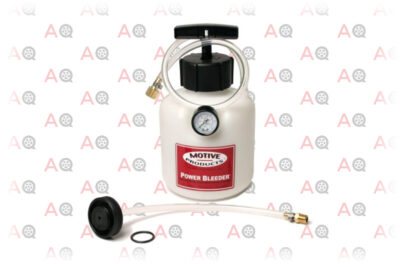
Editor’s Rating:
How to Use It
First, we have an important note concerning whether or not it will fit your vehicle:
IMPORTANT
Motive offers a variety of products that are all the same except for a single hose adapter. The one we’ve listed is compatible with most asian-made vehicles as well as American cars made by Ford. There is also a version for GM vehicles as well as one that fits most European automobiles. Read the description to make sure. They sell a lot of different ones, not just the ones we listed. Get the one for your car, or you’ll have to order an adapter separately, and who has time for that.
With that warning out of the way, the Motive bleeder works by creating pressure and forcing fluid through your system from the top. The first step is to attach the included cap to your brake fluid reservoir. That cap is the part that’s different from car make to make, so make sure to get the one for your car. To get the pressure, pump it up by hand. Fill the fluid tank, and you are ready to go.
Sometimes things are just easier to understand visually, so here’s a video of it in action by Blakes Garage.
Who it’s Best For
The Motive bleeder is perfect for the type of person that performs as much car maintenance as they can at home. It’s for the DIY mechanics and driveway warriors who are not afraid to wrench the entire weekend away on a project car. If you are only planning on one brake job a year, the Motive is a little much, and this Mityvac is more your speed. However, if you are changing out the fluid after every spirited drive through the canyons, the Motive is a lifesaver.
Our Thoughts
There is a philosophy that extends throughout the DIY world, and that is the fear of the unitaskers. Every tool should fill multiple roles and be good at everything. If you want that, get this Hydro-Turf. It’s good enough, but that’s not the thinking behind the Motive Pressure Bleeder. The Motive is just really good at pushing fluid out of a bunch of hoses.
So good that it’s easily the most complete way to replace brake fluid and bleed a system. Everything else might be able to do it, but nothing else will do it as well or with as much control. Unless you want to pay crazy money for this premium tool, that still won’t be as convenient, but why would you.
Pros
- Does the job of bleeding a system really, really well
- Has adapters available for any car
- Good quality parts
Cons
- Really only good for bleeding brake and clutch lines
- Setting it up is a bit complicated
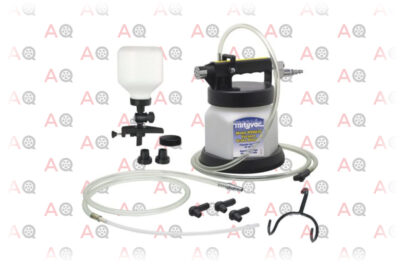
Editor’s Rating:
How to Use It
This is the most complicated unit on our list, so the best way to understand how to use it is to watch this video by OLCTinfo.
The short of it is that you use compressed air to create suction. That suction pulls the fluid through a check valve (this is one of the only units that includes its own check valve) and into a large reservoir.
Who it’s Best For
Since you need an air compressor and you need a ton of set up time, this is really a tool that’s only good for someone that does a lot of work with brake fluids. If you are a weekend mechanic or an entry-level DIYer, you’ll be spending a lot of money for a system that you won’t get much use out of. Just grab a hand tool like the HTOMT and call it good enough.
Our Thoughts
If you have an air compressor and are comfortable with the brake fluid changing process, the Mityvac is a dream. You just squirt air through the unit and suck all the fluid out, the end. It’s really fast and holds a lot, which is pretty much useless if you’re just doing a quick bleed.
It’s hard to justify the cost. If you aren’t running a semi-pro or pro shop, it’s not worth it. You save a few minutes or so every corner, which adds up to hours if you do multiple services a week. An hour of shop time would pay for this unit twice. If you’re just an every so often kind of brake servicer, you could buy 5 HTOMTs and still be coming out ahead in value.
Pros
- Fast
- Automatic, you won’t have to hurt your hands or feet pumping
- Holds a lot of fluid
Cons
- It’s complicated, especially compared to other units
- It’s expensive
3. Best Budget Pick: HTOMT 2 in 1
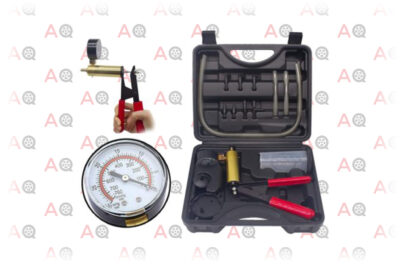
Editor’s Rating:
How to Use It
Connect a tube to the bleeder screw, then connect the other side to the little reservoir. Connect another tube from the other side of the reservoir to the hand pump. Open the bleeder screw, then pump until it draws fluid into the reservoir. Keep going until all the air is out, but don’t let the Master Cylinder level get too low.
Like with the other units, we found you a video that shows the process of using this unit. This time it’s one by Ry the Car Guy, who gets a little long-winded. Very thorough, though. Just as a note, he uses the ABN vacuum, which is the same unit as the HTOMT. In fact, the same unit is labeled a hundred different things, it just depends on where you buy it.
Who it’s Best For
This tool is the right tool for the home mechanic that has to bleed a line every so often. It’s not great if you have to do a lot of brake work, the Motive is the tool for more hardcore use, but it’s perfect for an every so often thing.
It’s also cheap enough that even if you don’t plan on bleeding a system right now, you can pick one up and just have it as part of your kit just in case. Worst-case scenario, you can charge your friends a six-pack to borrow it and come out ahead.
Our Thoughts
This is the cheaper of the two hand pumps on our list. Compared to the Mityvac, the HTOMT is a bit lower in quality, takes a bit longer to work, and isn’t as comfortable. None of those make it bad, though.
This kit comes with all the adapters you could want, and it comes with its own case. That case might actually be what we like best about it. Most budget tools don’t include a way to store them, and with a tool like a brake bleeder that you’ll only use every so often, being in a case will keep it nice during the months between uses.
The only real issue is that the more you use this kit, the more you’ll notice the lack of quality. They get sloppy over time and will lose vacuum power. As we said before, if you are doing a lot of fluid changing just get the Motive, don’t bother with a tiny hand pump. If you want to stick with a hand pump, just replace the HTOMT when it breaks. They are so cheap, it’s not worth fixing them.
Pros
- Inexpensive
- Easy to use
- Comes with a case
Cons
- Quality could be better
- HTOMT isn’t a “real” brand, and you can find the same unit all over the place with a different brand label
4. Best High Capacity Bleeder: Hydro-Turf Oil Extractor
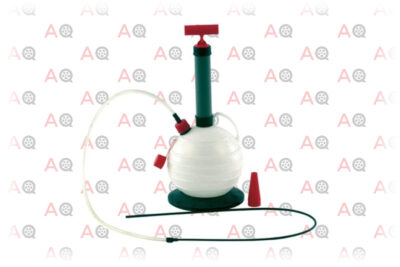
Editor’s Rating:
How to Use It
Connect a hose to the bleed screw, and connect the other to the extractor. Use the hand pump to build a vacuum inside the extractor, and then treat it just like any smaller vacuum pump. What you need to pay attention to is the fluid leaving the caliper when you disconnect it. Unless you use a valve like the Motion Pro, the system can suck air back into the lines when the vacuum is released.
More importantly, keep an eye on the reservoir for the master cylinder. The Hydro-Turf will suck the entire system dry in a matter of minutes. Accidentally replacing all of your fluid with air while trying to get rid of a few bubbles is the definition of suck.
Who it’s Best For
A large fluid extractor like the Hydro-Turf has tons of uses. If you have a small shop and hate unitaskers, it’s great to have tools like a large extractor. Especially if you are here looking for a bleeder, and you don’t have an oil extractor already, you should get this one.
Oil extractors will change the way you do maintenance forever. You just suck all the oil out of the dipstick tube into the easy-pour container. No crawling in the dirt to get the freeze plug out, pouring hot oil all over your hands and driveway when it misses the drain pan.
Our Thoughts
There are better oil extractors on the market. We’ve even written about them before; products like the Topsider are more suited for oil changing. There are also better bleeders out there, like the Motive we list.
However, even though there are better tools for each of the jobs, there are no other units that fill both roles so conveniently. The Hydro-Turf is lightweight, needs no power tools, and has a good-sized pump that makes it easy to draw out a lot of fluid.
It’s a bit unfriendly if all you want to do is bleed brakes, though. There are some difficulties with tube sizing, and it will require some DIY to get it to function well. Using it for bleeding also carries the genuine risk that you will accidentally suck way too much fluid out of your system. You have to be really vigilant if you use it as a general-purpose vacuum pump.
Pros
- Large capacity
- Fast
- Great for other things as well
Cons
- Requires some DIY if you don’t have standard bleed screws
- There are easier ways to bleed a brake system
5. Best Hand-Powered Vacuum Bleeder: Mityvac MV800

Editor’s Rating:
How to Use It
The Mityvac MV800 is a simple hand vacuum pump. You connect a hose to your brake line that goes to a reservoir, then you connect the reservoir to the tool. Squeeze the handle a bunch to draw a vacuum and watch it suck fluid and air into the reservoir.
Check out our guide here for general brake bleeding practices or watch this video by Pet Rock’s Garage, he uses the exact same model.
Who it’s Best For
The MV800 is the perfect tool for someone that probably won’t bleed brake lines very often but still wants a good quality tool they can rely on. A simple vacuum pump like this Mityvac has many uses, but the time it takes to draw the fluid will lead to hand cramps. If you have to do a lot of operations every year, it will make you wish you had a pneumatic tool like this one.
Our Thoughts
There are two hand vacuum pumps on our list. This is the more expensive one. The other, the HTOMT, works fine. It will hold a vacuum, draw out fluid, and probably have an adapter that fits on your caliper. It’s cheaper and comes with a case, too. Why would you get the Mityvac if the cheaper HTOMT would suffice? It’s because the Mityvac will last you through your tenth time using it, and the ergonomics of it are way better.
It has a trigger release for the air pressure instead of a funky hard to press button, and it has contoured handles instead of hard, flat metal ones. The fittings are a little more durable than the HTOMT’s, and it can draw a vacuum just a bit faster. In short, it’s more expensive, but your hands will appreciate it more.
Pros
- Good quality
- Easy to use
- Comes with a large variety of attachments
Cons
- Isn’t good for a large volume of fluid
- More expensive than similar tools
6. Best Air Compressor Powered Bleeder: 8milelake Pneumatic Bleeder
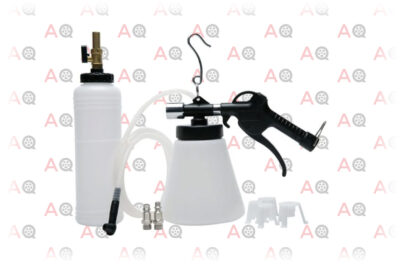
Editor’s Rating:
How to Use It
The 8milelake Pneumatic Bleeder works like the hand vacuum units like the HTOMT, it just uses an air compressor to “pump” instead of your fingers. You connect a hose that runs from the bleeder screw to the unit, then squeeze the trigger.
The compressed air creates a venturi, which creates a vacuum and sucks the fluid and bubbles right out of the system. Just be aware, just like with other budget units, this one has no check valve.
Supercheap Auto, who you likely know of in the US because they sponsor the Mighty Car Mods, did this video on a similar unit. They call it a Toledo, but like with the HTOMT and Pittsburg Tools, the Toledo and the 8milelake are the same thing.
Who it’s Best For
It’s best for anyone with the same requirements as the HTOMT unit, but who has an air compressor handy. It’s not a unit for doing a ton of fluid changes, it’s just good for a brake service every so often. If you want to use air pressure and need to do a ton of fluid work, get the big Mityvac. It’s got check valves and accessories that make everything faster.
Our Thoughts
If you have an air compressor handy, the 8milelake is a great unit. It has all the convenience and fluid extracting power of a hand pump without the cramps. The reservoir is slightly bigger too, so you can pull out more fluid. That means this is one of the faster tools on this list. Honestly, since it’s powered by an air compressor, that’s exactly what you’d expect.
The price is what really sets this one apart. It’s cheap. Partly because it’s a rebranded Harbor Freight tool. This means the old adage “you get what you pay for” rings true, just like with anything from HF. It’ll probably work, but it also might break after the 4th use. It’s easy to replace, though, since they are dirt cheap.
Pros
- Fast
- Easy to use for a pneumatic unit
- Inexpensive
Cons
- Quality could be better
- Easy to accidentally let air back into the system since it’s fast and has no check valve
7. Best Simple Brake Bleeding Tool: Motion Pro One Way Valve
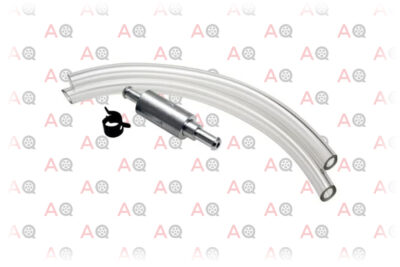
Editor’s Rating:
How to Use It
You connect the valve to the bleeder valve with a hose. Make sure the arrow is pointing the right way. What it does is make sure that you can’t suck air back into the line, eliminating the need to keep a constant eye on the container you are draining into. As long as you keep the cylinder reservoir full, you can just flush fluid out forever and know you’ll eventually get rid of all the air.
It works just fine alone, just drain into a bucket or something. Where it really shines, though, is in conjunction with other pumps. Bleeders like the HTOMT or the Bleed-O-Matic don’t have built-in one-way valves, so you can speed up the process by running the Motion Pro in line with them.
Who it’s Best For
It’s our opinion that if you work on cars, you should have one of these in your toolbox. They are cheap, work in a huge variety of applications, and make a perfect backup when you can’t find your HTOMT vacuum pump.
Our Thoughts
The Motion Pro one way valve is such a simple unit there isn’t much to say about it. It’s a small metal thingamajig with a hose on each side, and it only allows stuff to travel through it in one direction. It does everything it claims, and the likelihood of it failing for no reason is minuscule. Unless you run something sticky or chunky through it, it will work. Don’t do that.
Even though this costs more than the Bleed-O-Matic, it’s more useful. You don’t need a dedicated catch bottle. An old Monster can works fine as a container, and with the check valve, it’s easy to bleed the brakes solo.
Pros
- Infinitely useful
- Not likely to ever break
- Inexpensive
Cons
- Easy to lose
- Using it by itself takes a bit of practice.
8. Easiest to Use: OEM Tools Bleed-O-Matic
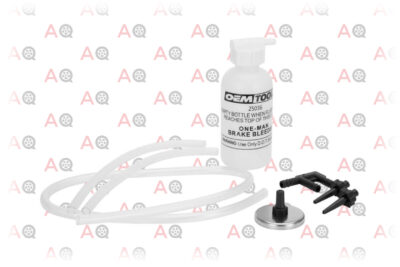
Editor’s Rating:
How to Use It
Hook the bottle to the bleed screw with the hose. Pump the brakes a few times, then open the bleed screw until the air is out. You will probably have to do that multiple times per caliper. You can also just let gravity do all the work. If you vent the top of the system and keep the reservoir full, the fluid will slowly drain into the bottle. Eventually, the air will work it’s way out. That’s probably the slowest way to bleed a system, though.
The Error Code Guy has a video where he uses one here, and you can hear his frustration through the entire thing. We disagree with some of his findings, it’s totally doable if you are alone, but it does illustrate really well the limitations of this kind of kit.
Who it’s Best For
Need to bleed a brake system and only have like $10 to do it? Here you go. Honestly, you might as well grab one for any system. It makes a convenient catch tank that you can use for many different vacuum or pressure tools. If you can work it into your plan, get a one-way valve like the Motion Pro to use with the tank. You can just open the bleed screw and pump the brakes until the air is out without running back and forth that way.
Our Thoughts
It’s hard to have thoughts about a tool that is little more than a magnet attached to a bottle with a straw. It does what it says. It’s the slowest, most frustrating thing to use because you’ll be running between the master cylinder, the brake pedal, and the bleed screw the entire time it drains. It does what it says it does, though, and you can do a whole brake fluid flush by yourself.
Get the HTOMT to have a better time. It’s twice as much, but it’s approximately 100 times less frustrating. Get the Bleed-O-Matic if you plan on doing like one brake job ever. After, either throw away the thing, or add it to your toolbox to be used as an oil applicator.
Pros
- Cheap
- Very, very straightforward to use
- Makes a good addition to other units
Cons
- Takes forever to bleed a system
- Unless you use a check valve, you risk introducing air into the system if the pressure depletes
9. Best Syringe Style Extractor: ARES 70920
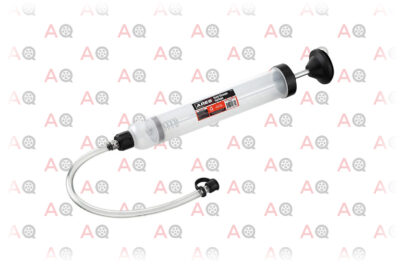
Editor’s Rating:
How to Use It
Stick the hose on the bleed screw. Start to open the bleed screw and then pull the plunger to suck the fluid out.
Bleeding brakes isn’t what it’s most useful for, though. It can do it, but what it’s good at is sucking all the fluid out of the master cylinder reservoir when doing a fluid change or flush. Especially if you have a reservoir that is hard to get too. We’re looking at you owners of old VWs.
Who it’s Best For
Along with the Motion Pro, the ARES is another tool we just think every person who works on cars should have. It has a million uses. You can add fluid to a hard to reach spot, you can suck up samples from places like the rear differential, and you can bleed smaller systems much faster than a vacuum pump can.
Our Thoughts
It’s probably painfully obvious at this point, but we love tools that have a lot of uses. Most people are limited by the amount of space they have to work with, so something small and infinitely useful is perfect. Especially since it comes with a detachable hose and is easy to take apart. Some units are all one piece, or difficult to break down. That makes keeping them clean a nightmare. The ARES is robust and easy to clean, so you won’t feel bad tossing it into a drawer with other tools.
They are also partnered with the ASPCA, which is a weird perk to include with an automotive tool. If you love animals, then why not support companies that support causes you like?
Pros
- Easy to clean
- Good for hard to reach areas
- Has a good capacity for a syringe style unit
Cons
- It’s a bit on the expensive side for a simple tool
- It can bleed brakes, but there are way better ways to do that.
10. Best Total Brake Service Kit: Performance Tool W180
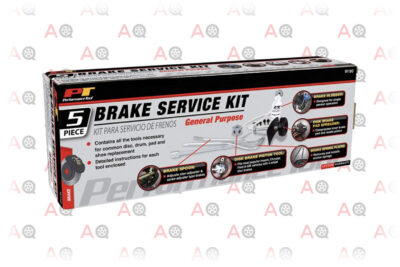
Editor’s Rating:
How to Use It
The bleed tool itself works just like the Bleed-O-Matic. You attach the bottle to your caliper, open the fitting and pump the brakes until there are no more bubbles.
The rest of the tools are for all sorts of different things. The piston tool is great for changing brake pads on disc brakes, the spring tool is essential for servicing drum brakes, and the pry bar will somehow find its way into every project you take on.
Who it’s Best For
The new mechanic who decided that they want to take a journey into the world of automotive repair. Someone who doesn’t have the money to buy all the parts separately. Someone who saw the price tag on the cheap HTOMT pump and were worried they would still need to buy a spring tool. The neophyte that will use all the included tools exactly once before deciding it wasn’t worth it to skimp out, and will go back over this list right after they finish their first caliper replacement.
Our Thoughts
If you’re bleeding brake lines, you are probably doing other brake work as well. Something like replacing a caliper, adjusting shoes, or repairing a damaged line. All those tasks require special tools that the average new mechanic won’t have. This kit has those special tools.
They are low-quality garbage, sure. That doesn’t mean they aren’t useful, especially the pry bars. You’ll find yourself using those for anything. Opening a paint can, popping off dash components, stabbing a hole in a grease container after the tab breaks off, really the uses are limitless. That makes it worth it alone, and if you do one brake job with the pliers, then the set has paid for itself.
Pros
- Includes all the tools for brake work
- Simple and easy to use
- Inexpensive
Cons
- Quality is questionable
- There are definitely better options if you just care about bleeding lines
Guide to Brake Bleeding
You made it down to this section? Awesome. Welcome, now that you’ve chosen the best brake bleeding tool for you, we are sure you’d like to know more about bleeding brakes. Maybe you haven’t decided yet, and you still just want more info to make a decision. Either way is fine with us. Things like “why” and “how” are great things to know about, so let’s look at that.
Brake Bleeding Is an Important Part of Maintaining Your Car
Whenever you change a brake component, whether you are upgrading a part or replacing a part, you introduce air into the system. It is also just something that happens over time as the fluid breaks down or components leak just a little.
Air compresses, and that means that instead of the fluid pushing on your brake components when you press on the pedal, you will just be compressing the air. If you have a lot of air in your brake system, your brakes won’t work.
Brake Bleeding Frequency
The average car just needs a good brake bleed about once a year to stay up to speed. If you do a lot of driving, consider upping that to every six months.
Also, any time you change a component like a caliper or line, bleed the entire system. Any time you have to add fluid, you should bleed the system. Before every race, if you are into that sort of thing, you should bleed the system just in case. Nothing is more embarrassing than boiling your brakes on the first lap just because you were too lazy to spend 5 minutes refreshing the fluid.
Flushing Your Brake Fluid
Cars.com recommends changing your brake fluid between every 3-years and never. That’s more or less a roundabout way of saying, “check your manual.”
However, we at AQ understand that there’s a difference between regular service, and the type of service you perform to make your car better. Flush your brake fluid more frequently than the manual recommends if you do a lot of spirited driving and boil your brake fluid often. Especially if you take it to a track or do a lot of AutoX events, you will probably want to change your fluid as often as you change your pads.
Choosing a Brake Fluid
If you are doing a lot of driving, live in a hot area, or plan on racing, there are high-performance brake fluids like the Brembo LCF600 or the AP Racing R series that will suit your needs better. More expensive, higher quality fluids will have a higher boiling point, meaning they will break down slower and work longer under intense driving situations.
Your car won’t really benefit from such high-performance fluid. You shouldn’t be driving your daily ride hard enough to boil standard brake fluid, and you’ll just be wasting money if you buy the expensive stuff. If you are taking a “trip to Mexico,” the expensive fluids can be the difference between stopping with your brakes or stopping because you hit a tree.
How to Bleed Brakes
We hate it when “read the manual” is an answer to so many questions, but read the owner’s manual first. You may also want to check out our step-by-step guide to bleeding brakes. In general, you will start with the furthest point away from the master cylinder. That’s the passenger rear wheel on most cars. It might not be, and that’s why you have to read the manual.
Once you are at the furthest point, locate the “bleeder screw.” All hydraulic systems have one, and most have many. On disc brakes, it’s on top of the caliper; on drum brakes, they like to hide it behind the dust cover. Clean the area really thoroughly before hooking anything up. Pro Tip: cover the bleed screw in brake line safe grease to avoid accidentally sucking air.
When it’s clean, hook a hose to the bleed valve and follow the instructions on whatever kit you are using. Suck fluid until the air bubbles stop, then close the screw. Move to the next furthest point, which is the driver’s side rear wheel on most cars and repeat the process. Work your way up to the very last point, then you’re done.
We included a lot of videos in the descriptions of each product that go through the entire process, like this one, so check there if you prefer more visual learning.
Do You Need a Special Tool at All?
No. You’ll notice that a lot of the tools specify that they just make it easier to do a brake fluid change alone. That might lead you to believe that if you’re willing to do things the hard way, you don’t need a tool at all, and you can save money by rigging something up. You’d be totally right. Mechanics all over the world do entire brake services with nothing but an old Powerade bottle and some leftover fuel line.
A cheap vacuum pump is like $20, though, and will cut the amount of time it takes to bleed a brake system in half. Honestly, that’s probably too conservative an estimate. It can take hours to bleed a system while a dedicated tool can do it in minutes. You can save money on the tool, but how much is your time worth?
Maintaine Brakes Offer Better Stopping Power
Brakes are important. Don’t take our word for it, try driving without them for a while. Actually, don’t do that. We don’t endorse driving without brakes. You know full well that brakes are essential.
Servicing your brakes and keeping them in top working condition is one of the most satisfying pieces of maintenance you can do to your ride. Grab one of the excellent tools up there and get wrenching!


